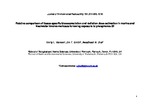Relative comparison of tissue specific bioaccumulation and radiation dose estimation in marine and freshwater bivalve molluscs following exposure to phosphorus-32
| dc.contributor.author | Vernon, EL | |
| dc.contributor.author | Smith, JT | |
| dc.contributor.author | Jha, Awadhesh | |
| dc.date.accessioned | 2018-09-13T11:26:42Z | |
| dc.date.issued | 2018-12 | |
| dc.identifier.issn | 0265-931X | |
| dc.identifier.issn | 1879-1700 | |
| dc.identifier.other | C | |
| dc.identifier.uri | http://hdl.handle.net/10026.1/12350 | |
| dc.description | publisher: Elsevier articletitle: Relative comparison of tissue specific bioaccumulation and radiation dose estimation in marine and freshwater bivalve molluscs following exposure to phosphorus-32 journaltitle: Journal of Environmental Radioactivity articlelink: https://doi.org/10.1016/j.jenvrad.2018.07.005 content_type: article copyright: © 2018 Elsevier Ltd. All rights reserved. | |
| dc.description.abstract |
With respect to environmental protection, understanding radionuclide bioconcentration is necessary to relate exposure to radiation dose and hence to biological responses. Few studies are available on tissue specific accumulation of short-lived radionuclides in aquatic invertebrates. Short-lived radionuclides such as 32Phosphorus (32P), although occurring in small quantities in the environment, are capable of concentrating in the biota, especially if they are chronically exposed. In this study, we firstly compared tissue specific bioaccumulation and release (depuration) of 32P in adult marine (Mytilus galloprovincialis, MG) and freshwater bivalve molluscs (Dreissena polymorpha, DP). Secondly, using the Environmental Risk from Ionising Contaminants Assessment and Management (ERICA) tool, we calculated tissue specific doses following determination of radionuclide concentration. Marine and freshwater bivalves were exposed for 10 days to varying 32P concentrations to acquire desired whole body average dose rates of 0.10, 1.0 and 10 mGy d-1. Dose rates encompass a screening dose rate value of 10 μGy h-1 (0.24 mGy d-1), in accordance with the ERICA tool. This study is the first to relate tissue specific uptake and release (via excretion) of 32P from two anatomically similar bivalve species. Results showed highly tissue specific accumulation of this radionuclide and similarity of accumulation pattern between the two species. Our data, which highlights preferential 32P accumulation in specific tissues such as digestive gland, demonstrates that in some cases, tissue-specific dose rates may be required to fully evaluate the potential effects of radiation exposure on non-human biota. Differential sensitivity between biological tissues could result in detrimental biological responses at levels presumed to be acceptable when adopting a 'whole-body' approach. | |
| dc.format.extent | 312-320 | |
| dc.format.medium | Print-Electronic | |
| dc.language | en | |
| dc.language.iso | en | |
| dc.publisher | Elsevier | |
| dc.subject | Bioaccumulation | |
| dc.subject | Radiation | |
| dc.subject | Bivalves | |
| dc.subject | Uptake | |
| dc.subject | (32)Phosphorus | |
| dc.subject | ERICA tool | |
| dc.title | Relative comparison of tissue specific bioaccumulation and radiation dose estimation in marine and freshwater bivalve molluscs following exposure to phosphorus-32 | |
| dc.type | journal-article | |
| dc.type | Journal Article | |
| plymouth.author-url | https://www.webofscience.com/api/gateway?GWVersion=2&SrcApp=PARTNER_APP&SrcAuth=LinksAMR&KeyUT=WOS:000446289100033&DestLinkType=FullRecord&DestApp=ALL_WOS&UsrCustomerID=11bb513d99f797142bcfeffcc58ea008 | |
| plymouth.volume | 192 | |
| plymouth.publication-status | Published | |
| plymouth.journal | Journal of Environmental Radioactivity | |
| dc.identifier.doi | 10.1016/j.jenvrad.2018.07.005 | |
| plymouth.organisational-group | /Plymouth | |
| plymouth.organisational-group | /Plymouth/Admin Group - REF | |
| plymouth.organisational-group | /Plymouth/Admin Group - REF/REF Admin Group - FoSE | |
| plymouth.organisational-group | /Plymouth/Faculty of Science and Engineering | |
| plymouth.organisational-group | /Plymouth/Faculty of Science and Engineering/School of Biological and Marine Sciences | |
| plymouth.organisational-group | /Plymouth/REF 2021 Researchers by UoA | |
| plymouth.organisational-group | /Plymouth/REF 2021 Researchers by UoA/UoA06 Agriculture, Veterinary and Food Science | |
| plymouth.organisational-group | /Plymouth/Research Groups | |
| plymouth.organisational-group | /Plymouth/Research Groups/Marine Institute | |
| plymouth.organisational-group | /Plymouth/Users by role | |
| plymouth.organisational-group | /Plymouth/Users by role/Academics | |
| plymouth.organisational-group | /Plymouth/Users by role/Researchers in ResearchFish submission | |
| dc.publisher.place | England | |
| dcterms.dateAccepted | 2018-07-06 | |
| dc.rights.embargodate | 2019-7-17 | |
| dc.identifier.eissn | 1879-1700 | |
| dc.rights.embargoperiod | Not known | |
| rioxxterms.versionofrecord | 10.1016/j.jenvrad.2018.07.005 | |
| rioxxterms.licenseref.uri | http://www.rioxx.net/licenses/all-rights-reserved | |
| rioxxterms.licenseref.startdate | 2018-12 | |
| rioxxterms.type | Journal Article/Review |


